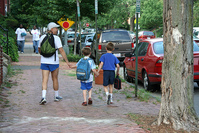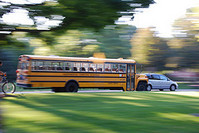How do parents pick schools?

Photo by jGregor on Flickr.
For parents in our region, the hardest quality-of-life, “why am I here?” question is not related to transportation or even crime or retail amenities, but education. Is this a good place to raise our kids and send them to school?
In DC in particular, this is the existential question that residents who are starting families have been asking themselves over and over since my wife and I moved here to start a family almost 10 years ago and surely long before then.
There are families who have been in DC for generations but decamped to the suburbs. There are those who moved to DC as singles or childless couples and began plotting their exit as soon as the pregnancy test came back positive. Maybe they’d stick around until their babies hit school age, or finish elementary school, but the question was when, not whether to leave.
Enrollment trends and anecdotes we pick up on the playgrounds and listservs make us wonder: How much of this is changing?

Public school enrollment turning the corner in DC.
DC has a vibrant system of charter schools, which are autonomous, tuition-free public schools. DC also has a school district whose leadership has been in the national news for hard-charging reform for over three years. Both the charters and DCPS have attracted hundreds of millions of dollars from private philanthropy.
The aggressive facilities modernization of DCPS has included several flashy projects that are visible from the street, not to mention the improvements behind the scenes. The “state” of DC is one of 12 to win a Race to the Top funding from the feds, a $75 million grant. We just had a Mayoral campaign in which both major candidates pledged to continue aggressive school reform, with the only differences being who and how to implement it.
As DC improves its schools, we should ask what, exactly, do parents look for in schools?
In the mid-90s I wrote a doctoral dissertation using econometric methods to estimate the value that urban parents placed on elementary school options. Based on their revealed preferences from school lottery data, how much farther would they send their kindergartner to attend a school with a special language immersion program? What effect does the racial composition of a school have on parents’ likelihood of choosing it for their own child?
How do they trade off distance and quality? Is there a tipping point when they switched from walkable distances to bus-rides? How do these individual preferences aggregate to affect racial segregation? What if you change the rules that constrain parental choice of schools?
I found that factors that were easy for me as a researcher to observe, as well as for parents to observe, like race and distance, were important. Looking at each race/ethnicity separately, all families had a preference for schools where their own group was represented, but according to my estimates each group (white, black, Asian/Hmong, and Native American) had a “bliss point” that was over 30% or 40% but well under 100%. In other words, everyone had both an own-race preference, but also a taste for diversity. (For smaller groups it was harder to achieve statistical precision in determining how strong that taste was or where the bliss point lay).
Distance was critical. Nobody wants to put their six year-old kid on a bus for an hour twice a day, right? Evidence suggested that there were parents who were wiling to pass by half a dozen schools on the way to one with a special program. Fast forward 15 years and I am married, we have a 6 year-old, and that is exactly what we do for an international baccalaureate school with Chinese immersion.
There was insufficient data to distinguish between the hypothesis that students were attending a school for its special program or to be with other kids like themselves. For example, if a school offers instruction in Native American Ojibwe language, does that explain why so many Native Americans cross town to attend, or is it because they want to be in a school with other Native Americans, or both?
Since then there have been some interesting research papers demonstrating further how school quality and race and ethnicity factor into residential and school choices.
The larger lesson for us is that where schools are located and what goes in them educationally will affect who attends them, which will in turn critically impact the city’s social makeup and fabric. And our tax base. They affect how we are distributed within the city, but across the region as well.
Almost six years ago my wife and I joined a group of parents who started our own public school through the chartering mechanism and many of our friends and neighbors have used the DCPS Out of Boundary choice system or moved to a particular DC neighborhood to select a traditional DCPS school.
I see anecdotally that more and more families are changing the question. Instead of “How long can we stand to stay here?” it’s “Which DC school is right for our child?” and “How long a commute to school can we handle?”
Maybe the big quality-of-life question is about transportation after all.

